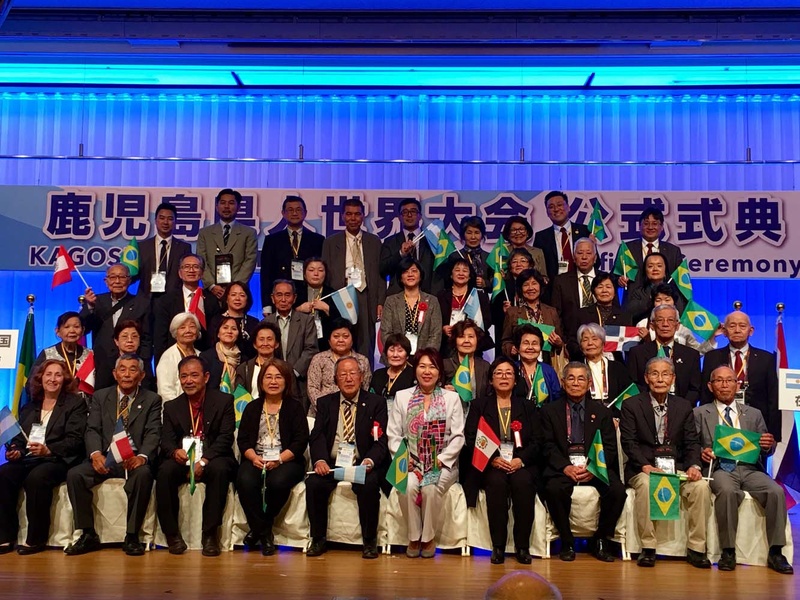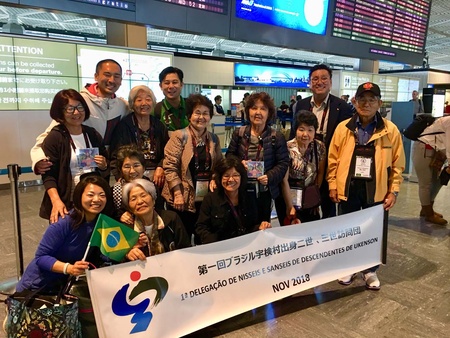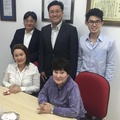On November 1, 2018, the "Kagoshima Prefecture World Convention" was held in Kagoshima, and overseas residents with ties to Kagoshima (approximately 280 people from 20 countries and regions) visited Kagoshima. A delegation of 27 people from Brazil came to Japan to participate in this convention, and 18 of them had ties to Amami. Why did so many of the Brazilian delegations have ties to Amami?
The purpose of the visit of the delegation, who are Brazilians with ties to Amami, was of course to participate in the World Congress, but in fact they had a much bigger reason. The first generation was to meet relatives and classmates for the first time in decades, and the second and third generation were to visit Amami, the hometown of their grandparents and parents, and visit their ancestors' graves. However, their main purpose was to convey their gratitude to the mayor of Uken Village on Amami Oshima.
In July of the same year, Uken Village, which sent the most immigrants to Brazil in Amami, organized a visiting group (led by Mayor Motoda Nobuari) to visit Brazil to participate in the "105th Anniversary of the Founding of the Brazilian Kagoshima Prefectural Association" held in Brazil. At this time, people from Amami living in Brazil and people with ties to Amami deepened their friendship with the visiting group led by the village mayor, and by hearing stories about Amami directly, they felt much closer to their "hometown, Amami," which they had only vaguely imagined until then. They knew that the Kagoshima Prefecture World Convention to be held in Japan was recruiting participants, but they thought it had nothing to do with them. However, when the visiting group came to Brazil from Amami, they felt like they wanted to go back to their hometown, Amami, and see Amami again! That was the first time they thought, "Let's go (to Amami)!" "We have to thank the village mayor."
In Brazil, where the economy was in a slump, it was difficult to save up enough money to travel to Japan. The long two-day plane trip was hard on the legs and back, so it took some courage. In addition, we were worried about whether the people of Japan and Amami would welcome us. Some of the members who came to Japan as "dekasegi" workers from Brazil in the 1990s had a hard time because of the language barrier. However, we felt that we should not miss this opportunity.
Welcome reception in Tokyo on October 31, 2018. On November 1 and 2, we moved to Kagoshima City to participate in the official ceremony and Ohara Festival. Before coming to Japan, we watched a video of the "Ohara Festival" in Brazil and practiced hard. "We're in Japan, so we have to dance properly," we said, and checked the choreography until just before the performance. We paraded around Kagoshima City for about an hour. In front of a large audience, we danced wearing the same T-shirts we made in Brazil. People along the road cheered us on, saying, "Go Brazil!" The mayor of Uken Village also came to support us.
The whole village of Amami welcomed them. When they came to Japan as dekasegi workers, they were always working and never thought about coming to Amami. The time they spent in Amami was "like a dream," said Norman Itsuo Takada (69), a second-generation Uken villager, when I went to the airport to see them off on the day they returned to Japan.
Uken Village held the "Uken Village Brazilian Immigration 100th Anniversary Exhibition (Sponsored by Uken Village Board of Education)" from October to the end of December 2018. The exhibition told the history of people from Uken Village and other parts of Amami who set out for the new world of Brazil, as well as the history of exchanges between Uken Village and Brazil that have continued for the past 100 years.
The author hopes that by learning about the history of immigration and migration, the people of Amami will have the opportunity to think about the people who are now migrating to Amami and our society, which is the side that accepts them. This is a valuable record of immigration to Amami, with prewar materials also on display. It would be a waste to hold the exhibition only in Amami. Therefore, the exhibition will also be held at JICA Yokohama in Yokohama Minato Mirai from March 30 to May 30, 2019. We hope that many people will come and see the 100-year connection between Brazil and Amami.
* * * * *
"Brazil and Uken Village, Amami: A Hundred Years of Pioneers Crossing the Sea"
Dates: March 30th - May 30th, 2019 Location: JICA Yokohama, 2nd floor corridor Free admission
*This article is reprinted from the Nankai Nichinichi Shimbun (November 29, 2018).
© 2019 Saori Kato










